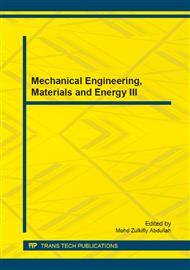p.289
p.297
p.301
p.305
p.309
p.315
p.322
p.326
p.330
Stress Analysis of Asymmetric Spur Face-Gear Pair Based on Finite Element Method
Abstract:
According to the theory of gear geometry, the equations of teeth surface of double pressure angles asymmetric face-gear were conducted. Discrete points were generated in MATLAB according to the surface equations, and then the author established contact finite element models of single-tooth pair in ANSYS. The calculated value of contact pressure of the single tooth contact finite element model and the calculated value of contact pressure which given by the point-contact Hertz theory were compared to verify the effectiveness of the contact finite element method. Several groups of parameters were calculated and the results showed that the use of reasonable asymmetric design can effectively reduce the max surface contact pressure and the max tooth root bending stress.
Info:
Periodical:
Pages:
309-314
Citation:
Online since:
December 2013
Authors:
Price:
Сopyright:
© 2014 Trans Tech Publications Ltd. All Rights Reserved
Share:
Citation:


